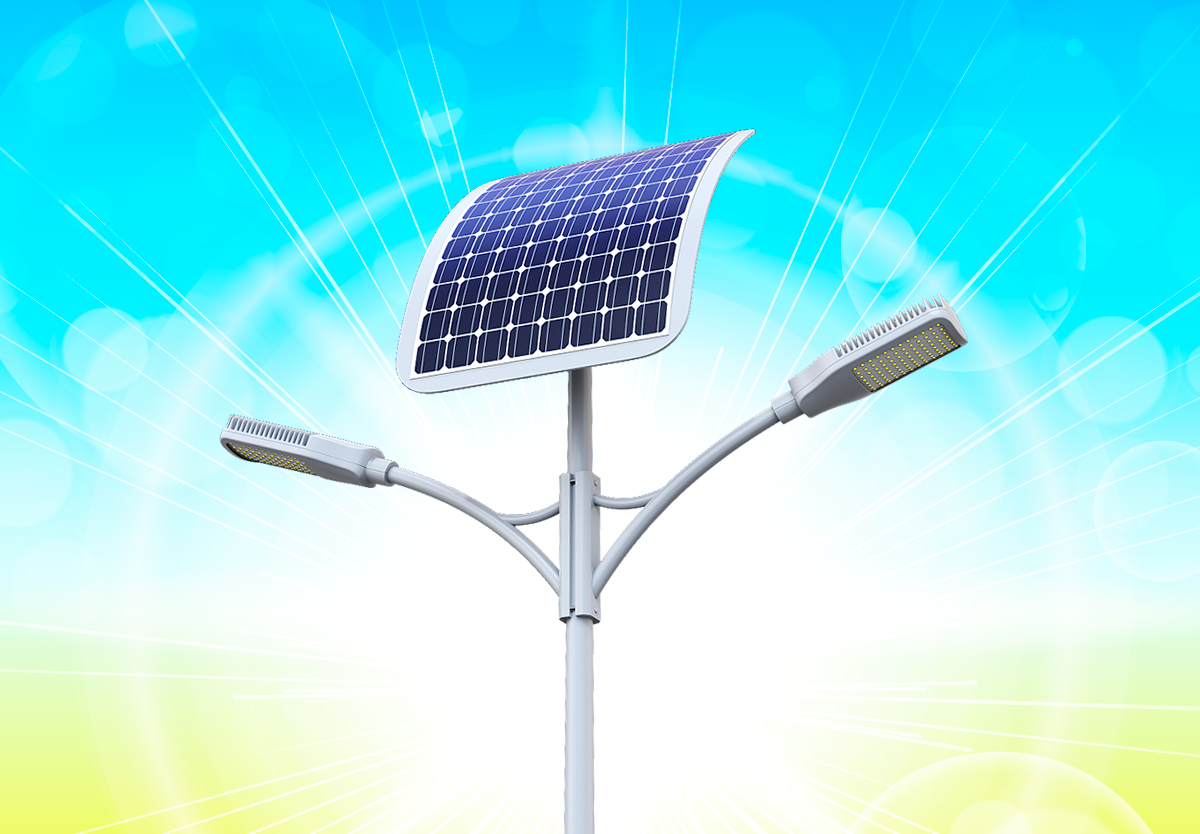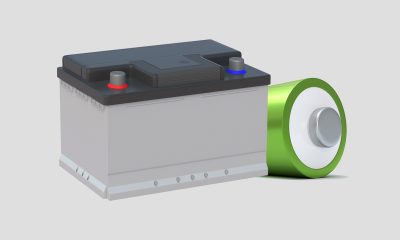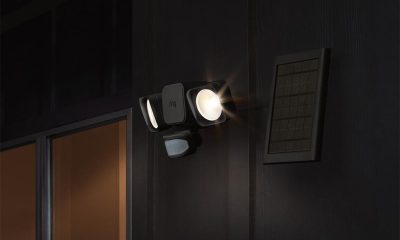The marriage between LED lighting and photovoltaics
Solar street lights are photovoltaic (PV) lighting systems that run off power collected from the conversion of solar energy. These roadway or area lighting systems are generally designed for off-grid applications where grid connected lighting is unavailable, costly or difficult to install. As solid state lighting based on LED technology pushes the boundaries of energy efficiency and life expectancy, there’s a growing trend towards the adoption of solar street lights in applications which were previously the realm of grid-dependent systems. The marriage between LED lighting and photovoltaics not only enabled significantly improved lighting performance but also offers the possibility of new lighting form factors.
In the era of solid state lighting, solar street lights come in two forms of system configuration: the split type and integrated type. A split-type solar street light takes a conventional design, whereas an integrated solar street light is self-contained system that incorporates the photovoltaic module, light engine, battery bank, charge controller, and lighting control components into one compact package.
Limitations to the all-in-one design
While the all-in-one design of integrated solar street lights simplifies installation by eliminating the need for external wiring between the sub-systems as well as lends the light fixtures an architectural appeal, it creates limitations in the size of the photovoltaic array and the storage capacity of the rechargeable batteries. The constraint to the light-receiving surface area of the solar panel, in particular, restricts energy generation of the PV system. As a result, the use of integrated solar street lights is limited to human scale illumination such as walkway, bikeway, local street and residential area lighting.
In order to serve roadway lighting applications that carry a large portion of vehicular traffic or large area lighting applications such as commercial parking lot lighting, the solar lighting system must be capable of producing a substantial amount of lumens at a mount height that allows for a sensible photometric performance. In areas where there are less hours of sun available for energy conversion, a high capacity photovoltaic system is often employed to maximize energy harvesting. The photovoltaic array therefore must be adequately large so as to put a sufficient amount of energy into the batteries, and the all-in-one design becomes meaningless in this case.
System configuration
A split-type solar LED street light is such designed that its performance is maximized to meet the requirements of demanding use. The need for this type of products is driven by their increasing deployment in roadway systems and remote areas that are beyond the affordable reach of utility power service and necessitate the use of solar lighting systems with lumen packages and reliability comparable to their grid-dependent counterparts. As the name suggests, a split-type solar street light has a discrete architecture in which the photovoltaic module and luminaire are supported by independent structures.
A typical split-type solar street light has a post top photovoltaic module and arm mounted luminaire. The battery system, depending on the type of its battery chemistry, is either integrated into the luminaire assembly/photovoltaic module or designed as an individual assembly for underground burial, on-pole attachment or base mount. The luminaire is generally mounted on a cantilevered arm designed for maximum efficiency in transverse (across-road) light distributions. It can also be mounted on an architectural or decorative arm such as the crook arm, ribbon arm, straight arm, swept arm, upsweep arm, or uplift adjustable arm.
Building blocks
The key functional components of a solar street lighting system include the photovoltaic module, battery system, solar charge controller, and the LED luminaire. The first three components constitute the solar power system. Consistent, reliable operation of the LED luminaire calls for a powerful solar power system.
Split-type solar LED street lights can be designed with the solar panel and battery capacities scaled to operate LED luminaires with a system wattage of up to 100 watts. Off-grid solar power systems must act to smooth out any fluctuations in solar generation and provide continuous release of energy to the load in times of rainy or heavily clouded days. The battery capacity is usually 3 to 6 times of the LED load and ranges from 60Ah to 200Ah. The presence of different types of solar panels, controllers, and batteries causes solar power systems to come in various configurations. The choice of system configuration is dictated by the photovoltaic resource of the geographic location, energy use of the lighting system, maintenance frequency, fixture design, budget, etc.
The photovoltaic module
A photovoltaic module or solar panel is constructed from an array of interconnected solar cells. A solar cell consists of two silicon layers doped with electron donor and acceptor materials, respectively. Solar radiation impinging on the surface of, and entering into, the substrate of a solar cell leads to the generation of negatively charged electrons and positively charged holes. The electron and hole pairs migrate to the p-n junction and create a voltage differential between the doped layers.
Solar cells are primarily made of crystalline silicon (monocrystalline and polycrystalline) and are connected in series and/or in parallel to attain a desired current. A monocrystalline solar cell is fabricated with its silicon wafer cut from a single crystal or ‘boule’ of silicon. A polycrystalline solar cell is cut from an ingot of melted and recrystallized silicon. Solar cells can also be manufactured by vapor-depositing a thin film of amorphous (non-crystalline) silicon onto a wide choice of surfaces. Monocrystalline solar cells, because of their cell structure and the lack of imperfections, have the highest efficiency of energy conversion. Polycrystalline cells are slightly less efficient than monocrystalline cells but they are cheaper to produce and have a better temperature de-rating co-efficient. Thin film solar cells are the least efficient of the three types, but they’re the least expensive to produce and perform as well as polycrystalline cells under higher temperatures (e.g. 25°C +).
Energy storage
The greatest challenge faced in developing solar street lights is energy storage. The energy output from the photovoltaic module is stored in a rechargeable battery or battery bank depending upon the requirements of the system. The capacity and cycle life of the battery is very important as they affect the backup power days and maintenance costs of the street lights.
Though various types of rechargeable batteries exist, the most commonly used battery in the split-type solar street lights is the deep-cycle lead-acid battery. The cost advantage is what this battery chemistry differentiates itself from the competing chemistries. There are two main families of lead-acid batteries: flooded and sealed. Flooded lead-acid batteries immerse electrode plates in a liquid electrolyte, which lends them the ability to operate efficiently even at low temperatures. However, these batteries require regular addition of water in order to replenish the electrolyte lost as gas through the battery’s vents during charging. Sealed lead-acid batteries are also called valve-regulated lead-acid (VRLA) batteries. They work on the recombination principle to prevent the escape of hydrogen and oxygen gases normally lost in the flooded counterpart.
The family of sealed batteries include gel batteries and absorption lass mat (AGM) batteries. Sealed lead-acid batteries are maintenance-free and have a higher energy density, low self-discharge rate and longer cyclic life than flooded lead-acid batteries. However, these batteries do not tolerate overcharging and require controlled charging.
Lithium batteries are finding their way into solar street lighting and have become the dominant choice of battery chemistry for use in all-in-one solar street lights. Their increasing popularity is due to their extremely high specific energy and power density as well as their excellent performance in terms of charge efficiency, charge retention, cycle life, and depth of discharge (DOD). Li-ion batteries are dual intercalation systems that use cathodes and anodes with structures capable of reversibly inserting and extracting lithium cations. Li-ion batteries designed for off-grid applications typically use lithium iron phosphate (LiFePO4) for the cathode positive electrode. The use of Li-ion batteries significantly reduces system size and product complexity of solar street lighting systems. However, battery management systems must be used with Li-ion batteries to protect the electrochemical cells from electrical abuse and provide adequate cycle lifetimes.
Solar charge controller
A solar charge controller is placed between the photovoltaic module and battery to monitor and control the power going into and coming out of the battery. It regulates the voltage and current coming from the solar panel and conditions them to ensure the battery is not overcharged. Most charge controllers have load control capability which prevents the connected loads from over-discharging the battery.
Charge controllers are basically DC-DC converters, where pulse width modulation (PWM) and maximum power point tracking (MPPT) technique are used to regulate the switches of the controller. The PWM charge controller uses a metal oxide semiconductor field effect transistor (MOSFET) as the power switch and regulates the output voltage by adjusting the duty cycle of the pulsed signal. The MPPT controller has control circuitry that seeks to find a module voltage at which the solar produces maximum power and uses a switching circuit to convert an input power at a module voltage to an output power for the battery at a load voltage. It tracks the maximum power point produced by a solar panel at all times in order to maximize energy production of the solar panel.
It is generally accepted that MPPT will outperform PWM at low temperatures and produce 10% to 40% more power with the same photovoltaic module than a PWM controller. The benefit of using MPPT controllers is most prominent in high power applications (150W and greater). Unlike the PWM control that requires the input nominal voltage to match battery’s nominal voltage, MPPT control allows the battery to be charged by a photovoltaic module with a substantially higher nominal voltage.
Disadvantages aside, PWM controllers are not without their merits. They perform well in warm temperatures (between 45°C and 75°C) and is a good low cost solution for low power (specifically low current) charging applications. PWM controllers have the ability to recover lost battery capacity, increase the charge acceptance of the battery, reduce battery heating and gassing, and deter the formation of sulfate deposits.
Load control and connected lighting
The charge controller is at the heart of every solar LED street light. In addition to protecting the battery from overcharge, overdischarge, overload and short circuit conditions, it works with the LED driver or incorporates driver circuitry to provide tight, efficient regulation and control on the current output provided to the LED load. The digital nature of LED technology enables many intelligent lighting features that allow for a more efficient utilization of electricity. Microprocessor controlled algorithms can be programmed to provide automatic dimming based on battery voltage and state of charge, thereby improving battery autonomy and enhancing battery lifespan. Adaptive controls such as motion detection and dusk-to-dawn sensing can be installed so that the LED driver will be able to communicate with its environment and automatically adjust light levels based on occupancy patterns and available daylight. Adding wireless connectivity to solar street lights allows both dynamic control of lights and networking of multiple lighting installations. Through the wireless communication network, the connected installations of solar street lights can easily be monitored, configured and controlled.
LED luminaire
A split-type solar LED street light has a self-contained LED assembly (luminaire). The use of a dedicated lighting system allows implementation of high performance thermal and optical systems. A robust thermal path can be constructed to provide adequate conductive and convective transfer of heat generated by the LED when power is applied to the LED junction to produce light. The cooler the semiconductor junction of an LED remains during operation, the better the lumen maintenance and the longer the life of the LED. Effective thermal management makes it possible to use reflective PLCC LED packages which deliver the highest efficacy among all types of LED packages but are prone to accelerated degradation under high thermal and electrical stresses.
Although the robustness of high power LEDs makes them the first choice of light source for outdoor lighting applications, the high luminous efficacy of plastic LED packages makes sound sense in efficient utilization of the captured solar energy and reducing battery DOD for longer autonomy periods and cyclic life. The luminous efficacy of mid-power LEDs has exceeded 200 lm/W and continues to improve toward the practical limit of 255 lm/W for phosphor-converted LED architectures. Beyond improved source efficiency, solar LED street lights typically use precision-molded compound lenses to improve optical delivery efficiency while providing superior photometric distributions tailored specifically to area or street lighting applications.



















Loading...
New member
New member